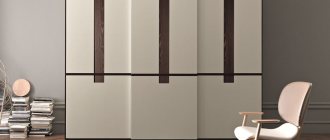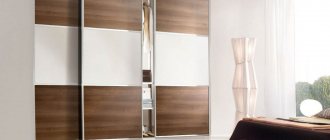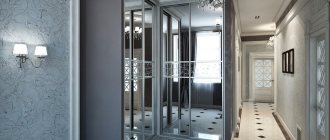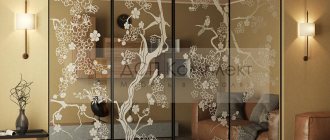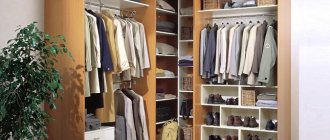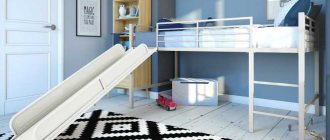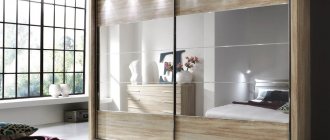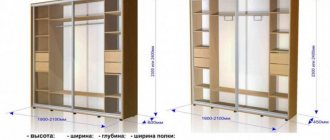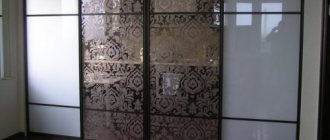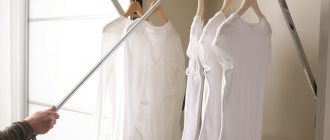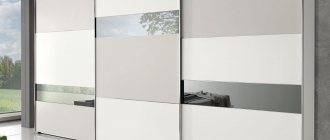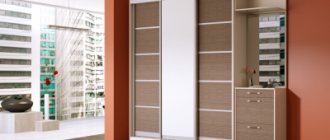Variety of radius designs
The main feature of radius sliding wardrobes is the absence of sharp corners. All outlines and lines are smooth, and the shape is curved or convex. The advantages of the designs include:
- high capacity, ergonomics;
- versatility of use - models are suitable for living rooms, children's rooms, bedrooms, hallways, as well as office spaces;
- a variety of options for internal filling and shapes;
- Possibility of installation in a corner or against a wall.
Disadvantages include high cost and complexity of installation. It is better to entrust the assembly of the radius cabinet to specialists. Structures are classified according to installation method. Each model has its own characteristics:
- Corpus. Equipped with back and side walls, lid, bottom, shelves. Installed in a pre-prepared place. Advantages - a wide range of models, furniture can be rearranged and transported. Disadvantages: dust accumulates behind the cabinet and on the top panel, high cost.
- Built-in. The products do not have side walls, lids, or bottoms. Mounted in corners, free niches. Advantages: lower cost compared to cabinet structures, ability to use all usable space, high capacity, masking of surface defects. Disadvantage: the models cannot be transported or rearranged to another location.
The radius cabinet can have a straight or angular shape. Linear structures are located along one of the walls. The advantages include versatility of use, convenience, and functionality. The main disadvantage is that they take up a lot of space.
The corner cabinet is equipped with symmetrical or asymmetrical fronts. Ideal for installation in rooms with limited space: bedroom, bathroom, loggia, hallway. The advantages of the models are versatility, space saving, aesthetic appeal. Disadvantages include installation difficulties and low strength of the sliding structure.
The radius cabinet occupies a minimum of usable space due to its small size or the absence of side walls, which are typical for standard rectangular models.
Hull
Built-in
Straight
Corner asymmetric
Corner symmetrical
Radius cabinet in the interior - role
A radius wardrobe is equally convenient in both spacious and small rooms. The semicircular shape fits optimally into almost any interior. Let's list the main applications.
- Living room. For placing books and decorative items.
- Kitchen. Depending on the upper or lower placement, it can be used under a sink, an extractor hood or as a storage system.
- Bedroom. It is used as a dressing room or for bed linen.
- Hallway. First of all, outerwear is placed here; some models are separately supplied with shoe racks.
If you decide to choose a radius corner cabinet, keep in mind that it must fit optimally into the room. This is the only way to obtain its main advantages, in particular, to achieve significant space savings. It is also worth considering the needs for storage systems; it is also worth selecting furniture based on this parameter.
Basic radial schemes
The range of radius cabinets is presented in several varieties, which differ in shape. When choosing, the parameters of the installation location and individual preferences are taken into account. Manufacturers offer the following options:
- Curved - a model in the form of a hemisphere with narrow side walls. Typically used to design built-in wardrobes, which are mounted in specially designated niches. An ideal scheme for areas where it is impossible to install standard structures.
- Concave - the door leaf is slightly recessed inward relative to the side walls. It is characterized by less capacity compared to the curved shape, but is distinguished by smooth lines and the ability to visually increase space.
- Combined or concave-convex - a radius cabinet combines the features of two varieties and has a wave-like shape. The models will become an original interior decoration.
- Asymmetrical - compact in size, high capacity. When decorating doors with reflective sheets, it helps to visually expand the space.
- Round - looks unusual, harmonizes with modern interior styles.
- Only with a side radius section - in appearance it resembles standard rectangular cabinets, in which one side is rounded. The products save space and look unusual.
Tips for choosing guides for sliding wardrobes, installation features
The choice of the optimal scheme depends on the characteristics of the room. Curved radius models are installed in small closets and hallways, which are converted into a dressing room. Cabinets with concave doors are often used to decorate a classic interior; asymmetrical ones are relevant for rectangular rooms. Round products are installed in spacious halls, living rooms, and serve to zone space.
Curved
Concave
Combined
Asymmetric
Round
With side radius section
Corner cabinet with a radius facade - features of the models
Corner modules are quite often used in small rooms. After all, fitting perfectly into a corner, such a cabinet makes it possible to optimally use the space that is not used by other furniture.
Depending on the features, such furniture can have the following form:
- semicircular;
- triangular;
- trapezoidal.
The non-standard type of furniture gives it the following advantages:
- space saving;
- aesthetics;
- high functionality.
Size options
Cabinets with radius doors are produced in different sizes, which allows you to choose the right model for spacious and small rooms. The following length options are common:
- Small - 800–1200 mm. Suitable for installation in small hallways, children's rooms, and office spaces.
- Medium - 1300–1800 mm. Optimal for small and spacious apartments.
- Large - 2000–3000 mm. Ideal for large rooms and country houses.
The height of radius cabinets varies. 2000 mm models are suitable for rooms with low ceilings. In most apartments, regardless of square footage, you can use structures with parameters up to 2400 mm.
The minimum depth of cabinets is 35 cm, the maximum is 1 m. The parameters are selected based on the width of the room in which the furniture is installed. The easiest way to calculate sizes is to use special computer programs. With their help, you can set the desired dimensions of the structure, select the number of doors, radial diagram, and type of material. The result will be a complete product design.
Small
Average
Big
Features of choosing a sliding system
The non-standard shape of cabinet and built-in radius wardrobes requires the correct choice of sliding systems. The reliability and ease of use of the design depend on them. The following options are in demand:
- Top-hung - most often used in built-in wardrobes, fixed to the ceiling. Before installation, the top surface will need to be reinforced so that it can support heavy weight.
- Based on the bottom rails - a universal sliding system that can be installed before or after installing the door leaf. The main load falls on the lower surfaces, so reinforcement of the ceilings is not required.
Great importance is given to fittings for radius sliding wardrobes. These are side profiles that act as handles, frames, rollers, door filling, stopper, assembly and adjustment screws. When choosing, you need to pay attention to the quality of workmanship, reliability of products, and manufacturer.
The best brands of sliding systems are considered to be Blum (Austria), Hettich (Germany). The range includes lifting mechanisms, hidden guides, furniture hinges and other products. The products of these companies are of high quality and are popular all over the world.
Top-hung sliding system
Support on the lower rails
Hettich sliding system
Furniture fittings Blum
Materials and internal filling
Cabinets should not only be aesthetically attractive, but also reliable and durable. The main characteristics of products depend on the material of manufacture. The following varieties are considered the most popular:
- Chipboard. The boards are made from a mixture of large wood chips and resin. Thanks to the variety of textures and colors, you can choose a radius cabinet for any interior. Advantages - affordable cost, versatility of use, light weight, resistance to mold, rot, attractive appearance. Disadvantages - content of toxic impurities, deformation when exposed to moisture, service life - up to 10 years.
- MDF. The material is made from sawdust and has greater strength and reliability compared to chipboard. The slabs have a perfectly flat surface and are suitable for creating concave or convex elements. Advantages: environmental safety, moisture resistance, long service life (from 10 to 30 years), ease of maintenance. Disadvantages - low resistance to high temperatures and mechanical stress.
- Tree. Traditional material for making sliding wardrobes. Budget furniture is made from birch and pine, expensive products are made from oak, cherry, and ash. Advantages - environmental safety, presentable appearance, durability, reliability, structures are subject to repair and restoration if there is serious damage. Disadvantages: high maintenance requirements, high cost, design does not always fit into modern interiors.
Popular styles and colors for wardrobes in the living room, examples of placement
When choosing a wardrobe, the internal contents must be taken into account. Boxes, shelves, shoe nets, baskets, stands, rods serve for convenient placement and compact storage of things. Ease of use of the furniture is ensured by additional equipment - pantographs. Thanks to the presence of a special handle, the bar with clothes can be easily lowered and extended to the optimal height.
Chipboard
MDF
Tree
Internal filling
Rational use of available space
Shelves, drawers and rods are needed for convenient placement and compact storage of things
Meeting hosts and guests
An excellent solution in terms of aesthetic improvement of an apartment can be radius cabinets in the hallway.
Living spaces furnished with such products immediately look impressive and fashionable. After all, the curved lines of the radius cabinet in the hallway immediately attract the attention of guests and serve as a sign of the well-being of the apartment owners.
The curved shape of the cabinet in the hallway allows for optimal use of the available space: in narrow areas the depth of the product decreases, in freer areas it becomes larger.
This form of products allows you to occupy any complex configuration of the hallway. Unlike straight forms, there are simply no such restrictions for radius furniture. The radial lines of the facade give a beautiful appearance.
Meanwhile, among the problems that accompany the decision in favor of this furniture, one should note lower capacity and limitations in materials.
For example, you cannot place a mirror on the facade, since the image of a person there will simply be a caricature.
Additional functionality
A standard radius wardrobe includes small and large storage compartments, rods and grids. No additional devices are provided in the designs. Such models are distinguished by their simplicity, practicality, and affordable cost. Improved options are equipped with functional devices:
- backlighting - for easy searching of things, an LED strip or spotlights are attached to the contours of the shelves;
- open shelves - allow you to place books, souvenirs, useful items;
- niche for a TV - a radius cabinet can be equipped with special sections for installing radio and television equipment;
- a compartment for an ironing board - this addition can be easily folded out and takes up minimal storage space;
- built-in furniture - in a small bedroom you can provide a dressing table hidden in the closet.
You can choose radius cabinet models, complemented by a full-fledged workplace and secretary.
The straight or corner design can be complemented by drawers with dividers for storing small accessories. The sides on the shelves prevent things from falling out, holders for skirts and trousers are equipped with rotating mechanisms, hangers for belts and ties are made in the shape of a fan. The fragrance section with a fan and aromatic balls quickly refreshes things and eliminates strong unpleasant odors.
Backlit
With open shelves
With a niche for a TV
With compartment for ironing board
With built-in furniture
Facade design
The appearance of the furniture depends on the finishing materials, decor, and colors used. In most cases, profiles for radius sliding wardrobes are made of aluminum. The most popular facade finishing options include:
- Lamination - such surfaces are resistant to household chemicals, moisture, and are not afraid of mechanical stress. The popularity of the material is explained by its ease of processing, low maintenance, and affordable cost.
- Mirrors improve lighting and visually increase the space of a room. For safety, the surface is covered with a shockproof film.
- Glass - facades can be glossy or matte, the decor is done using sandblasting and etching.
- Plastic - comes in a variety of colors, it is light weight, but such a facade needs protection from scratches and other mechanical damage.
Purpose of rollers for sliding wardrobes, methods of installing elements
Laminated surface
Mirrors
Glass
Plastic
Various combinations of materials are in fashion. The finishing of a radius wardrobe with a mirror is complemented by wood and plastic, glass is combined with MDF or chipboard. A popular design is in the form of thin metal strips that divide the surface into squares and diamonds, which are filled with stained glass windows and reflective canvases. To decorate original cabinets, non-standard options are used:
- Textured eco-leather - looks respectable and solid, will organically fit into the interior of a library, bedroom or office. The material is in harmony with metal, glass, wood.
- Metal inserts look unusual and are used to divide the door leaf into geometric shapes.
- 3D drawings - urban paintings in black and white and color, inscriptions, slogans, interesting ornaments are popular.
- Solvent, ultraviolet, polymer printing is performed using special inks. Images are bright and long lasting.
- Rattan - a lightweight, beautiful material of plant origin will make an ordinary straight cabinet a real decoration for a room decorated in an ethnic or Japanese style.
The colors of radius models come in a wide variety, but natural wood shades are the most popular. These are exquisite wenge, maple, rich tones of cherry, apple, noble oak, beech. A white cabinet looks luxurious, as well as milk, vanilla, and ivory.
Furniture finishing should match the interior or contrast with it. Cabinets can be painted in light yellow, salmon, blue, soft pink, green shades.
Textured eco-leather inserts
Metal elements
3D drawing
UV printing
With rattan
Accommodation Tips
Each piece of furniture must occupy a suitable place to ensure maximum functionality and an organic combination with the surrounding environment. Radius cabinets are indispensable in cases where it is necessary to hide irregular corners and save useful space. For optimal placement, it is recommended to take into account the purpose of the rooms:
- Living room or hall. Curved and concave cabinets are suitable. It is better to place furniture in a corner, which often remains free. Models with a niche for a TV and open shelves completely change the interior.
- Children's room. The ideal solution would be a built-in wardrobe. The design has no protruding corners, therefore it is considered the safest for the child. Positive green, blue, light pink, and orange tones are popular.
- Bedroom. Combined, round cabinets are used. Corner options can replace a full-fledged dressing room. Products must fit into the interior of the room; they are often offered in combination with other furniture.
- Hallway. Concave, asymmetrical, wavy models are relevant. Light colors are preferred; spotlights will make the closet feel light and airy.
In a bedroom or living room decorated in a classic style, it is possible to install radius hinged wardrobes. Sliding doors are appropriate only in modern interiors.
The dimensions of the radius cabinet must correspond to the parameters of the premises. For spacious rooms, products are selected in a tone darker than the main background. In conditions of limited space, light designs, decor in the form of mirrors, and photo printing are used. A radius wardrobe with curved fronts will give any room an unusual stylish look. The designs hide design flaws, save usable space, and allow for the most efficient use of space. Thanks to the variety of shapes, materials, and designs, you can choose the best option for any interior.
For the living room
For the bedroom
For children's
For the hallway
Types of corner radius cabinets
The design of radius furniture can be of the following types.
- Corpus. This is a full-fledged cabinet that has a full set of parts. The basis is the sides with a bottom and a lid. There is a back wall. This solution allows you to quickly and without any problems change the position of the furniture.
- Built-in. In this case, the supporting elements are the walls of the room. They fit perfectly into corners, making the best use of space. The only drawback is the inability to move the product to another location.
There is also a division by type of radius.
- Concave. In this case, the radius is concave inward. Here you need to take into account that such a solution slightly reduces the usable volume of the cabinet. At the same time, it is great for small rooms, as it visually makes them larger, especially when decorated with a mirror.
- Convex. The radius here goes out. Allows you to efficiently place a storage system inside. The furniture capacity is quite large.
- Wavy. In this case, convex and concave elements are combined.
